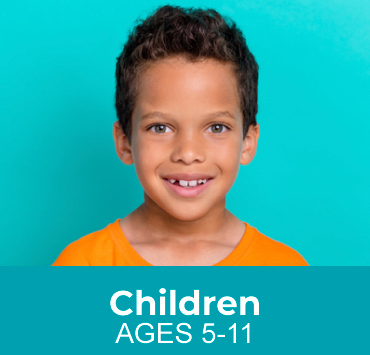It's a New Day in Public Health.
The Florida Department of Health works to protect, promote, and improve the health of all people in Florida through integrated state, county, and community efforts.
Children (ages 5-10)
 Healthy teeth are essential for your child to eat, speak, and grow properly. As children mature, they transition from baby teeth to permanent teeth. Baby teeth hold space for adult teeth, and taking care of both helps ensure a smooth transition as permanent teeth come in.
Healthy teeth are essential for your child to eat, speak, and grow properly. As children mature, they transition from baby teeth to permanent teeth. Baby teeth hold space for adult teeth, and taking care of both helps ensure a smooth transition as permanent teeth come in.
Caring for your child’s teeth early prevents issues like cavities (tooth decay) and gum irritation, setting the foundation for a lifetime of good health.
Focusing on oral health and building healthy habits helps children grow into healthy adults.
Daily Oral Care
- Brushing Teeth: Brush twice a day, after breakfast and before bedtime for at least two minutes, with a small, soft toothbrush and a pea-sized amount of toothpaste.
- Spitting Out Toothpaste: Ensure your child spits out the toothpaste or wipe it out with a clean washcloth.
- Helping with Toothbrushing: Children may enjoy brushing their own teeth, but they need assistance until ages 7-8. Try letting them brush first, then follow up by brushing their teeth again, if needed. It is recommended for parents to help their child brush until the child develops good brushing skills.
- Flossing: Begin flossing your child's teeth once a day when teeth start touching each other.
Engage in Oral Health Habits as a Family
Set a great example by practicing good oral hygiene with members of the family. Encourage:
- Brushing teeth twice a day with toothpaste and a soft toothbrush
- Flossing daily before bedtime
- Choosing water and healthy food items and limiting sugary food items and drinks.
- Visiting a dental professional regularly for cleanings and care
- Dental Health Visits
- Dental Sealants
- Toothbrushing and Flossing
- Healthy Eating Habits
- Importance of Vitamin D
- Physical Exercise and Safety
Maintain Regular Dental Visits
Visit a dental professional at least once per year or more often as recommended. Your dental professional will:
- Check your child’s mouth for healthy development
- Perform routine dental cleanings to remove plaque and buildup
- Take x-rays as needed to track permanent tooth development, cavities, growth and health, and tooth alignment
- Provide personalized advice on how to care for your child’s teeth
- Provide information about sealants once permanent molars come in, which can be an effective way to prevent tooth decay
- Check to see your child needs braces
- Your dental professional may also offer topical fluoride to help prevent cavities (tooth decay)
Contact a dental professional if you have questions or notice anything unusual.


The most important reason for getting sealants is to avoid tooth decay. Sealants cover the chewing surfaces of the back teeth and help to keep out bacteria.
Having sealants applied to teeth before they decay will also save time and money by avoiding dental procedures used to fix decayed teeth.
Dental Sealant Programs
The Florida Department of Health operates dental programs, including school-based sealant programs, in most counties throughout the state.
Contact your local county health department to learn more.
When Permanent Teeth Appear: Continue using a small, soft toothbrush and toothpaste when brushing.
Brush Twice a Day: Brush your child’s teeth twice a day, after breakfast and before bedtime for at least two minutes to help prevent tooth decay and gum disease.
Amount of Toothpaste to Use: A pea-sized amount.
Spitting out Toothpaste: Teach your child to spit out the toothpaste and rinse with water. If they struggle with spitting, gently wipe excess toothpaste from their mouth with a clean washcloth.
Helping with Toothbrushing: Children may like brushing their own teeth, but they need help until they are 7-8 years old. Try letting them brush first and follow up by brushing their teeth again if needed.
Flossing: Floss your child's teeth once a day when teeth start touching each other. Floss in between each tooth that touches another tooth. Gently glide the floss between the teeth and create a C shape with the floss to hug the tooth without injuring the gum. Raise the floss up slightly and form the C shape for the other tooth that touches.
Healthy Food Options
Provide your child with nutritious options like fruits, vegetables, whole-grain products, dairy products, lean meats, fish, eggs, and beans.
Ensure children receive adequate calcium each day to develop strong bones and teeth. Recommended calcium intake:
- Children ages 4-8 need 800 mg calcium each day
- Children ages 9-18 need 1,300 mg of calcium each day
Limit Sugary Drinks and Food Items
On average, sugar makes up 17% of what children consume each day.
Many foods or beverages have extra sugar and syrups added to them when they are processed or prepared. These added sugars have many different names, such as brown sugar, corn sweetener, corn syrup, dextrose, fructose, glucose, high-fructose corn syrup, honey, lactose, malt syrup, maltose, molasses, raw sugar and sucrose.
How often sugar is consumed is important for teeth. Frequent sugar sweetened drinks and snacks between meals can increase the risk of cavities (tooth decay).
- Provide children with healthier alternatives, like fruit instead of juice. Limit juice intake to four ounces per day for children ages 1-6.
- Encourage drinking water during the day, instead of juice, sugar sweetened drinks, or soda.
- Limit sweets like cookies, crackers, candy, gummies, dried fruits, ice cream, and cake.
Read Nutrition Labels
Many foods now list added sugar separately. You can find added sugar by reading the ingredients.
- Aim for less than 25 grams (about 6 teaspoons) of added sugar per day for children 2 years of age and older.
Serve Water and Milk
- Avoid soda, sports drinks, sweet tea, sweetened coffee, and fruit drinks.
- Milk contains natural sugar (lactose) and provides calcium, protein, vitamin D, and other nutrients children need.
Go Fresh and Limit Processed, Pre-Packed Foods and Drinks
Sugar is often added to pre-packed food and drinks while they are being made or at the table.
For example, there are hidden sources of added sugar in processed foods like ketchup, dried cranberries, salad dressing, and baked beans.
Instead, satisfy your child's sweet tooth with whole fruit.
Hydration and Dry Mouth Prevention
Some conditions and medications can cause dry mouth, increasing the risk of cavities (tooth decay). Ensure your child drinks plenty of water throughout the day.
It is recommended that children ages 4-18 need 600 IU of vitamin D each day.
Vitamin D supports bones and healthy teeth, by helping the body absorb and keep enough calcium and phosphorus. Vitamin D also plays a role in the immune system. Low levels of vitamin D in children are associated with higher cavity rates.
Your child’s skin characteristics can affect the vitamin D that their body makes. In particular, the pigment in your child’s skin is an important factor to consider; darker skinned people manufacture less vitamin D than those whose skin is lighter.
Getting Enough Vitamin D
Children and adolescents should receive a supplement containing 600 IU of vitamin D if they are not receiving this amount through their diet.
Children with an increased risk of vitamin D deficiency, such as those taking certain medications and with chronic diseases such as cystic fibrosis, may need higher doses of vitamin D. Consult with your child’s health care provider.
Natural Sources
Natural sources of vitamin D include salmon, sardines, tuna, mackerel, shitake mushrooms, and hard-boiled eggs.
Enriched foods are another way to increase the vitamin D in your child's diet. Look for foods fortified with vitamin D such as milk, cereal, orange juice, and yogurt.
Vitamin D is also made by your child’s body with the sun’s ultraviolet rays. When your child is exposed to sunlight, it helps their body synthesize vitamin D in the skin.
It doesn’t take much time in the sun to produce adequate amounts of vitamin D. However, not all children and adolescents get enough sunlight, particularly during certain times of the year or in northern regions of the U.S. Dense cloud covers can reduce the ultraviolet rays reaching the skin.
Encourage your child to exercise and spend time outside to improve or maintain overall health.
To protect their teeth, children should wear a mouth guard along with any other recommended protective equipment when playing sports or informal recreational activities. Ask your health care provider or dental professional for more information.
- If your child knocks an adult tooth out, pick the tooth up by the white part, not touching the root.
- If the tooth is dirty, rinse it gently with milk, salt water, or your child’s saliva and attempt to place it immediately back in its original position.
- Once the tooth is back in its original position, have your child bite gently on a clean gauze, a handkerchief, or napkin to hold it in place.
- If the tooth cannot be placed back in its original position right away, store the tooth in milk, your child’s saliva, or at least water.
- The tooth can then be brought with your child to their dentist, urgent care, or emergency room.
See a dental professional as soon as possible if your child injures a tooth or has a severe injury to their gums, lips, or jaws.



Connect with DOH